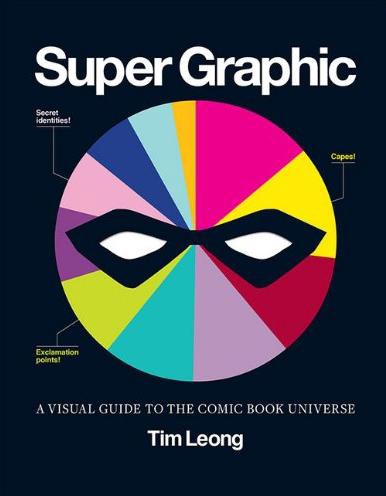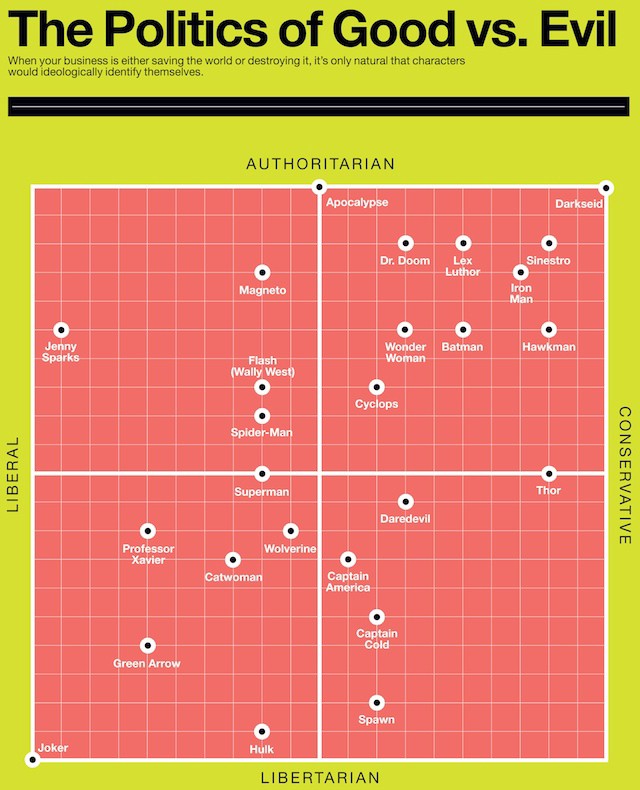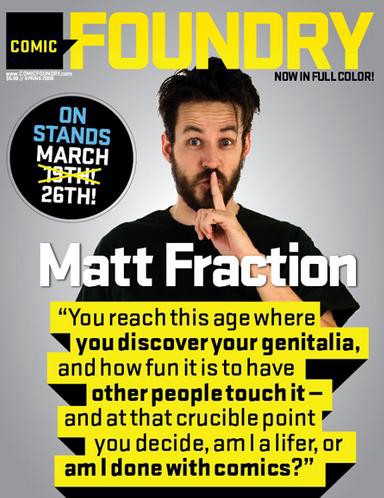A Chat With Tim Leong, Author Of "Super Graphic"

When I first held it in my hands, I was afraid it was a trifle, the kind of published material you might pick up at Urban Outfitters: maybe pics of misplaced apostrophes, maybe something about hipsters. But Tim Leong’s Super Graphic, to be published tomorrow by Chronicle Books, is different. It’s a little bit longer and wider than a book that might be based on someone’s Tumblr, and there are at least half again as many pages. Also, it is not trifling at all, which is quite an accomplishment for a book of charts and graphs that each deal with some dataset derived from comic books and the culture surrounding it. Each informational display stands by itself (“Supervillians and Secondary Colors” or “The Chris Ware Sadness Scale”), but taken as a whole it approaches something resembling a narrative. It’s a very heart-felt love letter to comic books, the imaginary people that inhabit them and the actual people that imagine the imaginary people.
I spoke to Tim, former Director of Digital Design for Wired and many other things, about his book, the comic book industry, magazine publishing and Matt Effing Fraction.
Brent: I didn’t really know what to expect and actually I really don’t know how to describe it. When you talk to strangers about your book, how do you describe it?
Tim: I tell them it’s a book of infographics that are about comic books. And then I have to give them a minute to, like, “Uhhh, OK?” I had a really hard time pitching it initially, because I didn’t have anything to compare it to. There’s another book that did something with baseball infographics, called Flip Flop Fly Ball, which is a great book, but there wasn’t an easy comparison.
Brent: Is “infographic” an accepted term of art now?
Tim: You know, I think it’s getting that way. I think people are definitely framing this as “infographics” and “data visualization.” I don’t think it all should be called that, but I think there have been some great infographics out there that are certainly worthy.
Brent: Yeah, I was struck by it. It’s kind of like learning how to read comic books when you’re a little kid. Like, It shouldn’t make sense, but then you read enough of it and it starts to, and you realize that it’s actually telling you a story.
Tim: You know, there’s so many of them. Infographics are definitely trending upwards. I think you’ve seen in the past couple years, especially online, a huge uptick in infographics. I think that’s because people have more access to data, and the tools for creating infographics are getting easier to use. But in that you’re getting all these infographics that look really cool but don’t actually make any sense. It looks gorgeous, but I have no idea what this is actually trying to tell me.
You, yes you, can purchase Super Graphic wherever you purchase such things!
• Amazon
Brent: It’s great because there are very factual graphs, or infographics, with very quantifiable numbers, and then there are the ones that, I don’t really know how to describe them, but like in your book, the infographic ends up looking like a picture of the character that it’s discussing?
Tim: Yeah, the character visualizations.
Brent: So you’re not trying to so much convey data as you are information about the character, or even your own opinion.
Tim: Well it’s kind of a mix. I think some of them are definitely information-heavy and you have to do deep data-mining to figure out some of the stuff and present it, and some of it is more subjective or my opinion, and some of them are just for fun. I didn’t want to have everything from start to finish be a super information dump. It would take some of the fun out of it, being such a dense read. I wanted to pace it both editorially and also visually, which is where I think you get some of those character visualizations.

Brent: What made you want to do this?
Tim: Well I’ve loved comic books my whole life. I used to have this magazine called Comic Foundry that I started.
Brent: I wanted to get to that, actually.
Tim: It was a magazine that started as a website, an online magazine, and then a print magazine. When we first launched it, all the print magazines for comics…
Brent: Like Wizard.
Tim: Like Wizard, were super heroes. That was the only thing they put out. There was the The Comics Journal, which is still around, which is fantastic, and which was mostly indie. But I was getting to the point where, I’m a comics reader, I like superhero stuff, I like indie stuff, I like manga stuff, but I couldn’t really find something that spoke to me in that way.
Brent: And what were you doing when you were starting this magazine. Was that like your full-time endeavor?
Tim: It was side-job. It was always a side-job. I worked at Men’s Health at the time. And we said, let’s make a comics magazine that we want to read. And the whole point of it, and it’s kind of the same theme as the book, is that everything in it might not be for you, but there’s something in there for everyone. No matter what your interest is or what your skill level is or what you know, you can be a hard-core comic book fan and find something interesting in it.
Brent: Actually, I read a couple issues. It was really great.
Tim: Oh wow!
Brent: It was great because it kind of simultaneously took the fannish-ness out of the fanboy and also appealed to the fanboy directly. It elevated from what the “comic-con” culture used to be.
Tim: Thank you. And the same thing with Comic Foundry and this book is trying to synthesize… You know, comics are tough. There are some obscure characters out there, decades and decades of history and these very obscure characters that if you’re not in the know, you’re not going to get. It can be a tough thing to get into sometimes. So I think the goal with these two projects was to synthesize some of this information and make it easier for people to get into comics.
Brent: At Wired you did a Batman infographic feature, right?
Tim: Yeah, I wrote a timeline — I didn’t design it, another fabulous designer at WIRED designed it — a timeline of Batman in film and on TV.
Brent: So was that kind of a precursor to Super Graphic?
Tim: The book was already well in progress at the time. You know, I’m used to working in magazines and the Web. You do it, and it goes up, and then you forget about it. Or you do it, and it’s on the stands a month later, and then you forget about it. With books, it’s crazy! They’re insane! They take forever! This was done a year ago, and I’ve just been waiting for this to come out.
Brent: So with Comic Foundry, you were pretty immersed in the comics industry. Do you miss that?
Tim: I actually did. I did miss it. Leaving the comics business was still the hardest decision I’ve ever had to make. I know it was the right decision, but it was definitely a hard one. Because when you’re in it, for so long, you read a story and you’re like, “What would be the Comic Foundry take on that? How would we make this a story?” For like a year after, I’d still keep thinking about Comic Foundry,and I definitely missed it. I missed being in the industry. The industry is a great place to be. And only tangentially, right? I’m not a creator or anything like that. But being in that world was just a great feeling and I definitely missed it.
Brent: So what killed the magazine?
Tim: Well, I was working at Complex magazine at the time, and I got promoted to design director, so I was a department head, so… it wasn’t a fair situation to put either magazine in. I couldn’t really split my time that way. It was a fantastic opportunity, and I was honored to get that promotion, and I had to honor them and do the best job I possibly could.
Brent: So you’re an old comics fan. What’s like your secret origin?
Tim: Heh. Um, I think the first book I remember reading, or at least the one that stands out, it was The Web of Spider-man I think? And they were doing these horrible horrible characters like Rocket Racer? He was like the one black character they had and he was on a rocket-powered skateboard…
Brent: Yes, he was. And I think he also had a boom box.
Tim: Yeah, yeah. And I think there was like a Nazi blob? Those were what I remember. Also, I loved Superman growing up. I loved Superman.
Brent: What are you reading now?
Tim: Now? I’m reading Hawkeye…
Brent: Of course. Which is the best comic ever.

Tim: It’s so fucking good. And what’s funny is that it doesn’t sound that difficult? You read it and you’re like, that wasn’t too hard. But that’s what kind of a good job Matt Fraction does.
Brent: I totally agree. He makes it look so easy and you just have to wonder, how come everyone hasn’t been doing this for the past forty years?
Tim: When someone is working at such a high level, they make it look so easy, and then you try to do it once, and it’s just like…
Brent: Well, and now we can look forward to ten years of people trying to rip Matt Fraction off.
Tim: Yeah.
Brent: But let’s get back to Super Graphic. On your acknowledgements page (in the form of an infographic), there’s a lot of people on there. So was this a solo endeavor, or was this a team effort?
Tim: This is 99% me. Most of those people are supportive people, people who were supportive of me professionally and personally.
Brent: Yes, I noticed some people in there with your last name.
Tim: But some people, I would do some stuff and give it to a friend and say, “Hey, does this make sense to you?” So a lot of people gave good solid feedback. And there were some people that did a little fact-checking and stuff like that.
Brent: Actually if there is any one thing that I could say that I wished the book had, it would be footnotes or endnotes. Because some of the research is mind-blowing.
Tim: Ah.
Brent: For example, the one about how many people the Punisher killed in the series? Did you actually read every issue of the series and count?
Tim: I did not. I was very thankful that Marvel actually put that together two years ago I believe? But Steve Wacker had put that together at Marvel.
Brent: And then the cities — like where Metropolis actually is. Is that a matter of public record, or is that a matter of conjecture?
Tim: All of the map stuff was taken from maps that were actually printed. You know, Metropolis is a tricky one, because they’ve kind of altered it over time. And that was kind of the toughest thing about doing this book is that comics have been around for a long time.
Brent: And they play fast and loose with that stuff sometimes.
Tim: Absolutely. And I’m sure you can find conflicting information on some of these things, but we looked at it this way: No matter what we printed, somebody was gonna be upset with something. People just love it so much, and they can be obsessive about comics, but, you know.
Brent: It’ll be interesting to see what some of the feedback is when this comes out.
Tim: [Laughs.] Yeah.
Brent: Because there’s gonna be some pretty obscure arguments against some of your work, I’m sure.
Tim: Oh sure! And I’m ready to… (Laughs.) With bated breath.
Brent: Of course. Did the publishers actually cooperate at all?
Tim: I did not work with the publishers. All this stuff I found in comics or in other research or in some of these databases or on the back of trading cards or somewhere else.
Brent: And it will be interesting to see what the publishers think. Of course they’re gonna like it.
Tim: A lot have creators have liked it so far.
Brent: Yeah, your pullquotes are awesome. So, comics are one thing, and design is another, and this is a pretty skillful display of design. Who are the people that you looked up to in design, especially in the magazine business?
Tim: Oh, wow. The team at Wired was actually fantastic. I was there for three years, I just left there last month…
Brent: Where are you going now?
Tim: Still trying to figure that out. I’ll be doing some book stuff right now. Hopefully I can figure out something. But yeah, the team at WIRED, they’ve done a lot of great work.
Brent: It’s funny, we’re coming into an age where people start knowing the names of the designers.
Tim: Which is really weird, because if you look at a magazine, every single person has a credit except for the designers, which I’m totally fine with. You know, we don’t get into magazine design for the credit. Like, “I really want to get my name on that spread!” That’s not how people think.
Brent: So how long did you work on it?
Tim: I would say probably that 90% of it was done in five or six months, and the rest was tweaking and adjusting and editing.
Brent: There will be some novelists that will be very jealous to hear that.
Tim: Well, I kinda pitched it like, “It’ll be really cool,” and they were like, “How about you turn it in on so and so date,” and I was like, “AAAH!” But any kind of a deadline, that totally helps.
Brent: Well, the book is great. Is there any question you’ve been waiting to be asked?
Tim: Um, I dunno. Dealing with Chronicle was great. Do you have the print copy?
Brent: I do, yeah.
Tim: You know, we were talking about covers. And they were like, “We should do a die-cut,” and I was like, “Oh, yeah! We should!” So big credit to them for pushing the book to be a better tactile experience.
